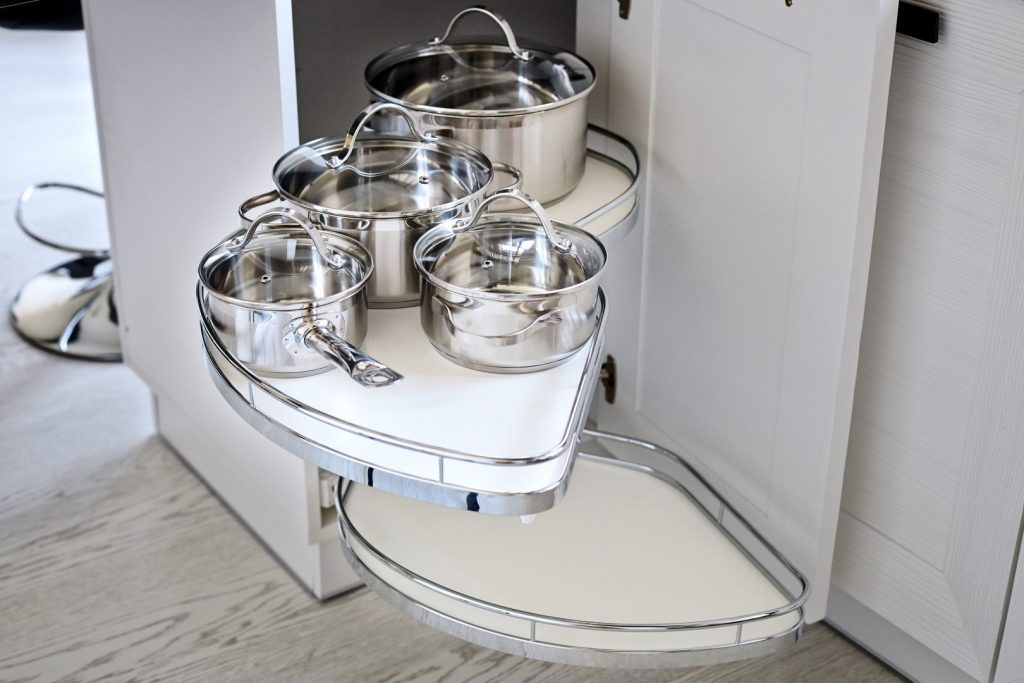
Pullout and rotating shelving inside cabinets bring the contents to the user, eliminating a lot of bending, lifting, and other considerations
A possible misconception about creating aging in place improvements or designs is that they need to address the specific needs of the client in a way that are obvious and thus noticeable to the client, other family members, and visitors to their home. We know that if someone has a ramp installed when it wasn’t there previously that it going to be an improvement that everyone can see – at least in the short-term. However, depending on how it is installed, its placement on the property, and any landscaping that is used to soften its appearance and provide a little privacy for the user, it does not need to be the main thing that someone notices as they approach the property. Also, the person for whom the ramp, in this case, is designed and installed doesn’t need to feel self-conscious about using it with other people possibly watching them.
Ramps are becoming quite popular and rank as one of the most requested and completed aging in place projects. Nevertheless, they can be constructed in a way that allows them to blend into the home’s exterior design as an integral part of it rather than something that has been added. It can look as if the home was designed to include this element rather than looking like it has been added because there was a need for it that had not been foreseen or anticipated.
This is the point of effective aging in place design and how universal design as a strategy or tactic helps us to implement changes that our clients need without calling attention to those changes. We want our clients to function well within their living space (and the area immediately around their home), and we can create improvements that are integrated into the home’s design rather than appearing as an addition – inside or out.
Safety considerations are a classic example of this. We can go through a client’s home and make several safety improvements in the form of more solid surface flooring, better illumination through more strategically placed light fixtures and lamps with the proper amount of intensity for the activities in that particular area of the home, locating light switches and other wall controls (fans and thermostats, for example) where they can be reached and used regardless of a person’s reach or ability, providing more comfort in the home in terms of air quality and temperature (heating, cooling, and water temperature as well), and helping out with other activities of daily living (including closet access, mirror placement, bathroom access, sleeping facilities, and kitchen usage).
In addressing any of these aspects of the home – essentially providing a greater degree of safety – the improvements that we offer can blend into the living environment without calling any special attention to the design other than it’s attractive.
Whether someone has a specific mobility limitation that affects how they move about their living space or how they sit, rise, retrieve, grasp, hold, and use common household items – or they are just dealing with the normal effects of getting older (sensory changes affecting vision, hearing, balance, and coordination, for instance), there are many improvements that we can install in their home that look attractive and appear to be effective.
Any person of any age likely will appreciate a strategically placed vertical grab bar and the entrance to their tub or shower – just in case. If they need it every day, fine. Otherwise, it’s there on those occasions when they do – dizziness, illness, medications, overexertion, leg cramps, leg or foot surgery, or slipping on the floor.
Once inside the tub or shower, it’s similarly nice to have a fold-down seat (if there is no bench installed) where they can sit or rest when they need to – if that’s each time they bathe or just occasionally. It’s also a great place to sit while using the handheld or personal shower that is a common element in the bathroom today. It can be used in place of or in addition to a fixed shower head.
In the kitchen, bathroom, bedroom and hall closets, laundry room, garage, or other storage places, pullout and pulldown shelves and bins provide easier access and retrieval of stored items. No one thinks anything about this convenience because it accommodates everyone and makes life a little simpler. It is beneficial to the aging client, but anyone can use and like these features.
Features or treatments in the home that accommodate aging issues often can be in such a way that no one thinks anything about them being present – they just fit in or seem to be part of the space. Single-lever kitchen faucets, lever door handles throughout, and rocker-style light switches are just some of the examples that accommodate aging or people with special needs, and it’s more obvious when they aren’t included in a living space than when they are present.
